Marketing Strategies: Comparing Sony PS4 and Nintendo Switch Consoles
VerifiedAdded on 2023/01/12
|8
|1989
|25
Report
AI Summary
This report presents a comparative analysis of the marketing strategies employed by Sony for the PlayStation 4 and Nintendo for the Switch gaming consoles. It begins with an executive summary followed by an introduction to the concept of marketing and its importance in the competitive gaming industry. The findings section delves into the target markets of each console, highlighting Sony's focus on young adults and Nintendo's emphasis on a broader age range including children. The report then examines the marketing mix, breaking down the product strategy (console specifications), pricing strategy (competitive pricing), promotion strategy (digital and traditional marketing channels), and place strategy (distribution channels) for both consoles. The analysis provides insights into how each company positions its product, identifies its target consumer, and uses the 4 Ps of marketing to drive sales and market share. The report concludes with a summary of the key findings and references the sources used.

Principal of Marketing
Paraphrase This Document
Need a fresh take? Get an instant paraphrase of this document with our AI Paraphraser

Table of Contents
EXECUTIVE SUMMARY.............................................................................................................3
INTRODUCTION...........................................................................................................................3
FINDINGS.......................................................................................................................................3
Target Markets.............................................................................................................................3
Marketing Mix.............................................................................................................................4
CONCLUSION................................................................................................................................7
REFERENCES................................................................................................................................8
EXECUTIVE SUMMARY.............................................................................................................3
INTRODUCTION...........................................................................................................................3
FINDINGS.......................................................................................................................................3
Target Markets.............................................................................................................................3
Marketing Mix.............................................................................................................................4
CONCLUSION................................................................................................................................7
REFERENCES................................................................................................................................8
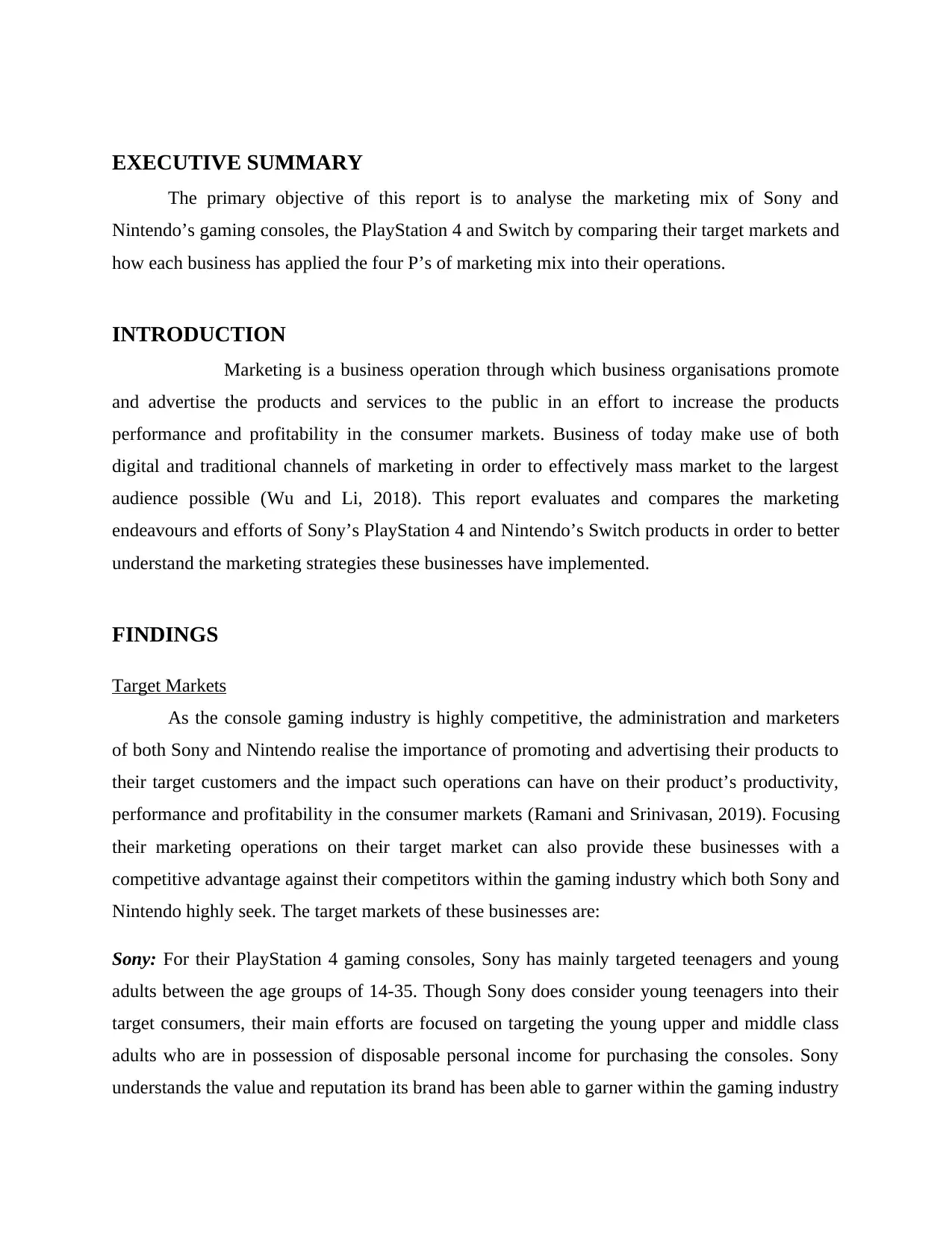
EXECUTIVE SUMMARY
The primary objective of this report is to analyse the marketing mix of Sony and
Nintendo’s gaming consoles, the PlayStation 4 and Switch by comparing their target markets and
how each business has applied the four P’s of marketing mix into their operations.
INTRODUCTION
Marketing is a business operation through which business organisations promote
and advertise the products and services to the public in an effort to increase the products
performance and profitability in the consumer markets. Business of today make use of both
digital and traditional channels of marketing in order to effectively mass market to the largest
audience possible (Wu and Li, 2018). This report evaluates and compares the marketing
endeavours and efforts of Sony’s PlayStation 4 and Nintendo’s Switch products in order to better
understand the marketing strategies these businesses have implemented.
FINDINGS
Target Markets
As the console gaming industry is highly competitive, the administration and marketers
of both Sony and Nintendo realise the importance of promoting and advertising their products to
their target customers and the impact such operations can have on their product’s productivity,
performance and profitability in the consumer markets (Ramani and Srinivasan, 2019). Focusing
their marketing operations on their target market can also provide these businesses with a
competitive advantage against their competitors within the gaming industry which both Sony and
Nintendo highly seek. The target markets of these businesses are:
Sony: For their PlayStation 4 gaming consoles, Sony has mainly targeted teenagers and young
adults between the age groups of 14-35. Though Sony does consider young teenagers into their
target consumers, their main efforts are focused on targeting the young upper and middle class
adults who are in possession of disposable personal income for purchasing the consoles. Sony
understands the value and reputation its brand has been able to garner within the gaming industry
The primary objective of this report is to analyse the marketing mix of Sony and
Nintendo’s gaming consoles, the PlayStation 4 and Switch by comparing their target markets and
how each business has applied the four P’s of marketing mix into their operations.
INTRODUCTION
Marketing is a business operation through which business organisations promote
and advertise the products and services to the public in an effort to increase the products
performance and profitability in the consumer markets. Business of today make use of both
digital and traditional channels of marketing in order to effectively mass market to the largest
audience possible (Wu and Li, 2018). This report evaluates and compares the marketing
endeavours and efforts of Sony’s PlayStation 4 and Nintendo’s Switch products in order to better
understand the marketing strategies these businesses have implemented.
FINDINGS
Target Markets
As the console gaming industry is highly competitive, the administration and marketers
of both Sony and Nintendo realise the importance of promoting and advertising their products to
their target customers and the impact such operations can have on their product’s productivity,
performance and profitability in the consumer markets (Ramani and Srinivasan, 2019). Focusing
their marketing operations on their target market can also provide these businesses with a
competitive advantage against their competitors within the gaming industry which both Sony and
Nintendo highly seek. The target markets of these businesses are:
Sony: For their PlayStation 4 gaming consoles, Sony has mainly targeted teenagers and young
adults between the age groups of 14-35. Though Sony does consider young teenagers into their
target consumers, their main efforts are focused on targeting the young upper and middle class
adults who are in possession of disposable personal income for purchasing the consoles. Sony
understands the value and reputation its brand has been able to garner within the gaming industry
⊘ This is a preview!⊘
Do you want full access?
Subscribe today to unlock all pages.

Trusted by 1+ million students worldwide
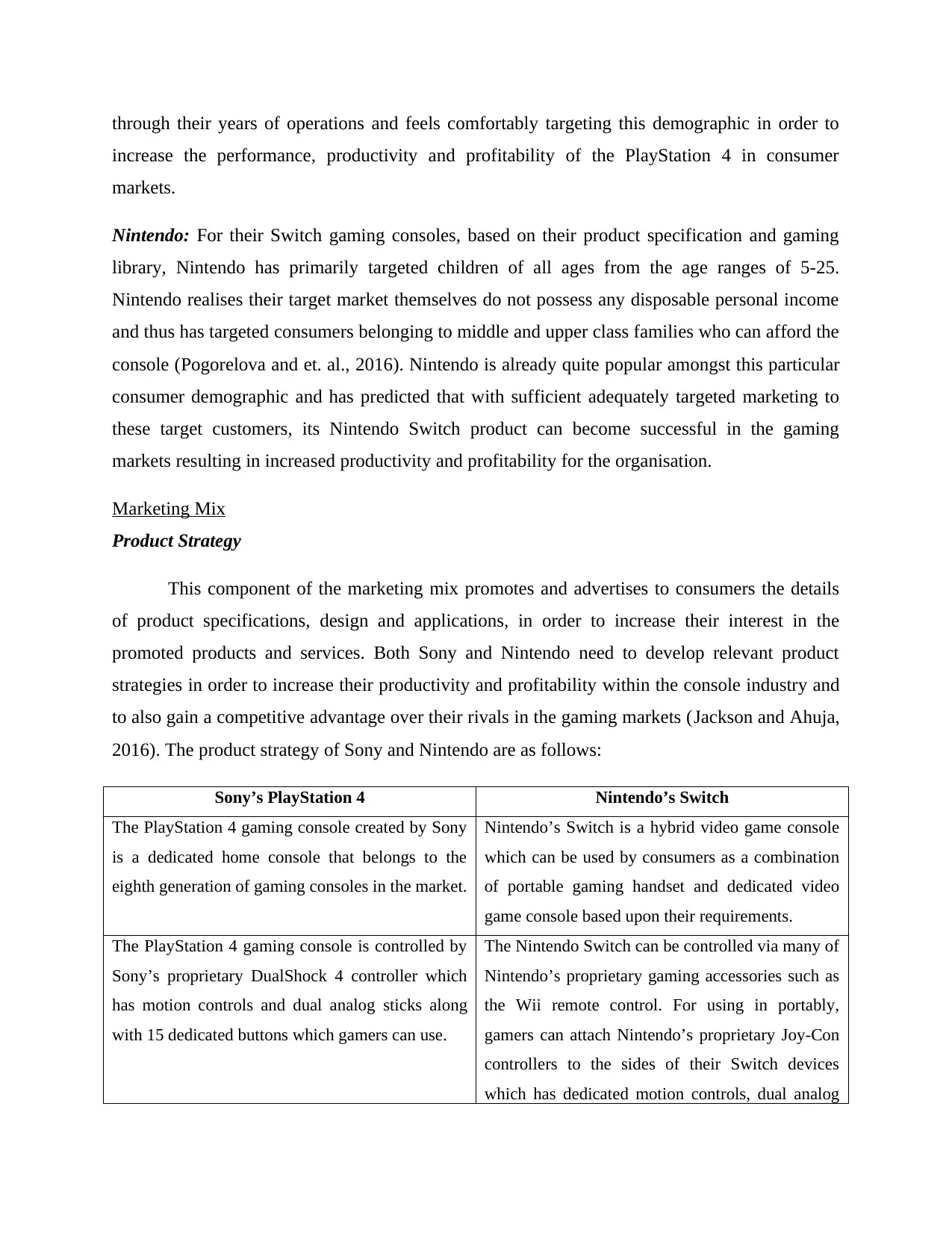
through their years of operations and feels comfortably targeting this demographic in order to
increase the performance, productivity and profitability of the PlayStation 4 in consumer
markets.
Nintendo: For their Switch gaming consoles, based on their product specification and gaming
library, Nintendo has primarily targeted children of all ages from the age ranges of 5-25.
Nintendo realises their target market themselves do not possess any disposable personal income
and thus has targeted consumers belonging to middle and upper class families who can afford the
console (Pogorelova and et. al., 2016). Nintendo is already quite popular amongst this particular
consumer demographic and has predicted that with sufficient adequately targeted marketing to
these target customers, its Nintendo Switch product can become successful in the gaming
markets resulting in increased productivity and profitability for the organisation.
Marketing Mix
Product Strategy
This component of the marketing mix promotes and advertises to consumers the details
of product specifications, design and applications, in order to increase their interest in the
promoted products and services. Both Sony and Nintendo need to develop relevant product
strategies in order to increase their productivity and profitability within the console industry and
to also gain a competitive advantage over their rivals in the gaming markets (Jackson and Ahuja,
2016). The product strategy of Sony and Nintendo are as follows:
Sony’s PlayStation 4 Nintendo’s Switch
The PlayStation 4 gaming console created by Sony
is a dedicated home console that belongs to the
eighth generation of gaming consoles in the market.
Nintendo’s Switch is a hybrid video game console
which can be used by consumers as a combination
of portable gaming handset and dedicated video
game console based upon their requirements.
The PlayStation 4 gaming console is controlled by
Sony’s proprietary DualShock 4 controller which
has motion controls and dual analog sticks along
with 15 dedicated buttons which gamers can use.
The Nintendo Switch can be controlled via many of
Nintendo’s proprietary gaming accessories such as
the Wii remote control. For using in portably,
gamers can attach Nintendo’s proprietary Joy-Con
controllers to the sides of their Switch devices
which has dedicated motion controls, dual analog
increase the performance, productivity and profitability of the PlayStation 4 in consumer
markets.
Nintendo: For their Switch gaming consoles, based on their product specification and gaming
library, Nintendo has primarily targeted children of all ages from the age ranges of 5-25.
Nintendo realises their target market themselves do not possess any disposable personal income
and thus has targeted consumers belonging to middle and upper class families who can afford the
console (Pogorelova and et. al., 2016). Nintendo is already quite popular amongst this particular
consumer demographic and has predicted that with sufficient adequately targeted marketing to
these target customers, its Nintendo Switch product can become successful in the gaming
markets resulting in increased productivity and profitability for the organisation.
Marketing Mix
Product Strategy
This component of the marketing mix promotes and advertises to consumers the details
of product specifications, design and applications, in order to increase their interest in the
promoted products and services. Both Sony and Nintendo need to develop relevant product
strategies in order to increase their productivity and profitability within the console industry and
to also gain a competitive advantage over their rivals in the gaming markets (Jackson and Ahuja,
2016). The product strategy of Sony and Nintendo are as follows:
Sony’s PlayStation 4 Nintendo’s Switch
The PlayStation 4 gaming console created by Sony
is a dedicated home console that belongs to the
eighth generation of gaming consoles in the market.
Nintendo’s Switch is a hybrid video game console
which can be used by consumers as a combination
of portable gaming handset and dedicated video
game console based upon their requirements.
The PlayStation 4 gaming console is controlled by
Sony’s proprietary DualShock 4 controller which
has motion controls and dual analog sticks along
with 15 dedicated buttons which gamers can use.
The Nintendo Switch can be controlled via many of
Nintendo’s proprietary gaming accessories such as
the Wii remote control. For using in portably,
gamers can attach Nintendo’s proprietary Joy-Con
controllers to the sides of their Switch devices
which has dedicated motion controls, dual analog
Paraphrase This Document
Need a fresh take? Get an instant paraphrase of this document with our AI Paraphraser
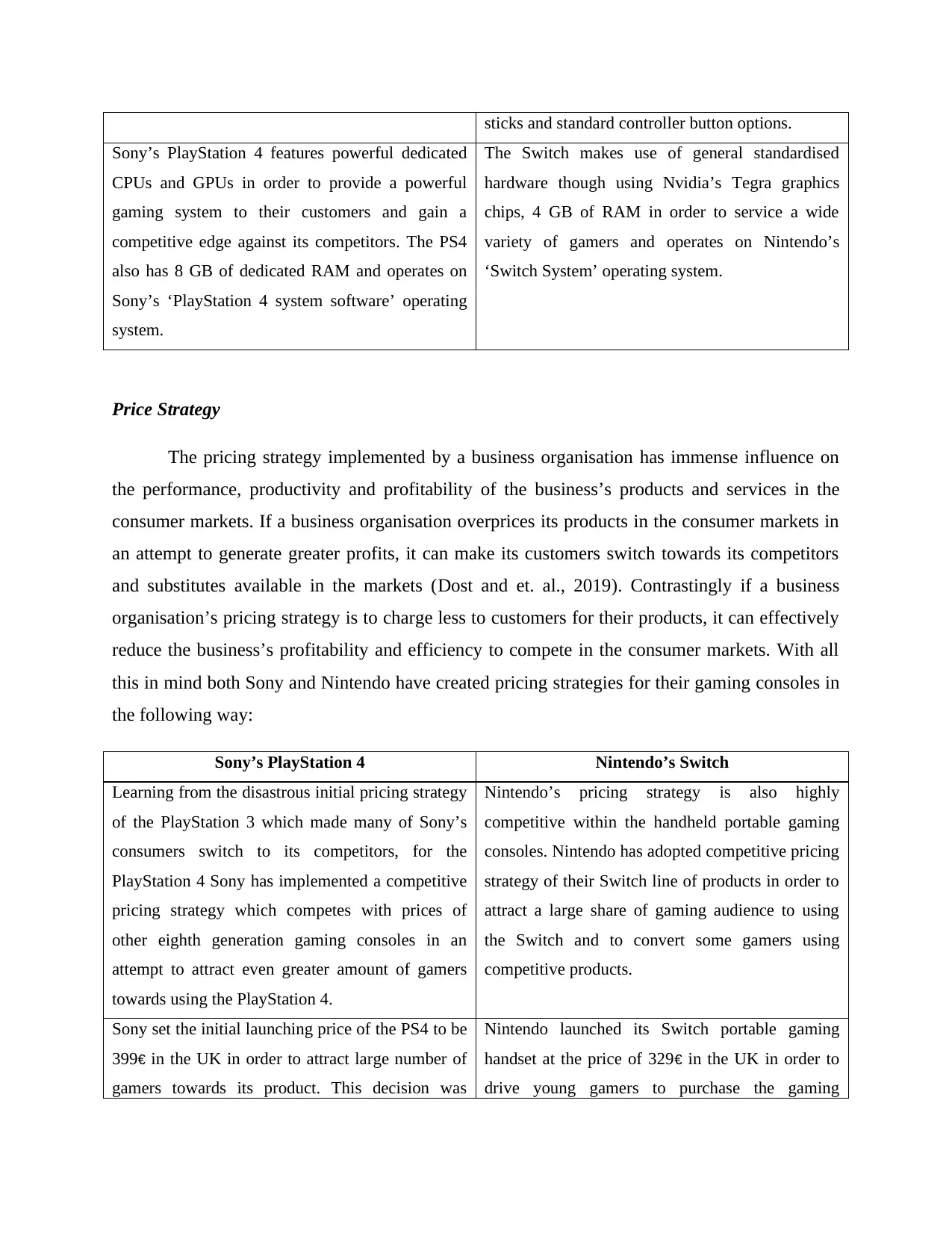
sticks and standard controller button options.
Sony’s PlayStation 4 features powerful dedicated
CPUs and GPUs in order to provide a powerful
gaming system to their customers and gain a
competitive edge against its competitors. The PS4
also has 8 GB of dedicated RAM and operates on
Sony’s ‘PlayStation 4 system software’ operating
system.
The Switch makes use of general standardised
hardware though using Nvidia’s Tegra graphics
chips, 4 GB of RAM in order to service a wide
variety of gamers and operates on Nintendo’s
‘Switch System’ operating system.
Price Strategy
The pricing strategy implemented by a business organisation has immense influence on
the performance, productivity and profitability of the business’s products and services in the
consumer markets. If a business organisation overprices its products in the consumer markets in
an attempt to generate greater profits, it can make its customers switch towards its competitors
and substitutes available in the markets (Dost and et. al., 2019). Contrastingly if a business
organisation’s pricing strategy is to charge less to customers for their products, it can effectively
reduce the business’s profitability and efficiency to compete in the consumer markets. With all
this in mind both Sony and Nintendo have created pricing strategies for their gaming consoles in
the following way:
Sony’s PlayStation 4 Nintendo’s Switch
Learning from the disastrous initial pricing strategy
of the PlayStation 3 which made many of Sony’s
consumers switch to its competitors, for the
PlayStation 4 Sony has implemented a competitive
pricing strategy which competes with prices of
other eighth generation gaming consoles in an
attempt to attract even greater amount of gamers
towards using the PlayStation 4.
Nintendo’s pricing strategy is also highly
competitive within the handheld portable gaming
consoles. Nintendo has adopted competitive pricing
strategy of their Switch line of products in order to
attract a large share of gaming audience to using
the Switch and to convert some gamers using
competitive products.
Sony set the initial launching price of the PS4 to be
399€ in the UK in order to attract large number of
gamers towards its product. This decision was
Nintendo launched its Switch portable gaming
handset at the price of 329€ in the UK in order to
drive young gamers to purchase the gaming
Sony’s PlayStation 4 features powerful dedicated
CPUs and GPUs in order to provide a powerful
gaming system to their customers and gain a
competitive edge against its competitors. The PS4
also has 8 GB of dedicated RAM and operates on
Sony’s ‘PlayStation 4 system software’ operating
system.
The Switch makes use of general standardised
hardware though using Nvidia’s Tegra graphics
chips, 4 GB of RAM in order to service a wide
variety of gamers and operates on Nintendo’s
‘Switch System’ operating system.
Price Strategy
The pricing strategy implemented by a business organisation has immense influence on
the performance, productivity and profitability of the business’s products and services in the
consumer markets. If a business organisation overprices its products in the consumer markets in
an attempt to generate greater profits, it can make its customers switch towards its competitors
and substitutes available in the markets (Dost and et. al., 2019). Contrastingly if a business
organisation’s pricing strategy is to charge less to customers for their products, it can effectively
reduce the business’s profitability and efficiency to compete in the consumer markets. With all
this in mind both Sony and Nintendo have created pricing strategies for their gaming consoles in
the following way:
Sony’s PlayStation 4 Nintendo’s Switch
Learning from the disastrous initial pricing strategy
of the PlayStation 3 which made many of Sony’s
consumers switch to its competitors, for the
PlayStation 4 Sony has implemented a competitive
pricing strategy which competes with prices of
other eighth generation gaming consoles in an
attempt to attract even greater amount of gamers
towards using the PlayStation 4.
Nintendo’s pricing strategy is also highly
competitive within the handheld portable gaming
consoles. Nintendo has adopted competitive pricing
strategy of their Switch line of products in order to
attract a large share of gaming audience to using
the Switch and to convert some gamers using
competitive products.
Sony set the initial launching price of the PS4 to be
399€ in the UK in order to attract large number of
gamers towards its product. This decision was
Nintendo launched its Switch portable gaming
handset at the price of 329€ in the UK in order to
drive young gamers to purchase the gaming
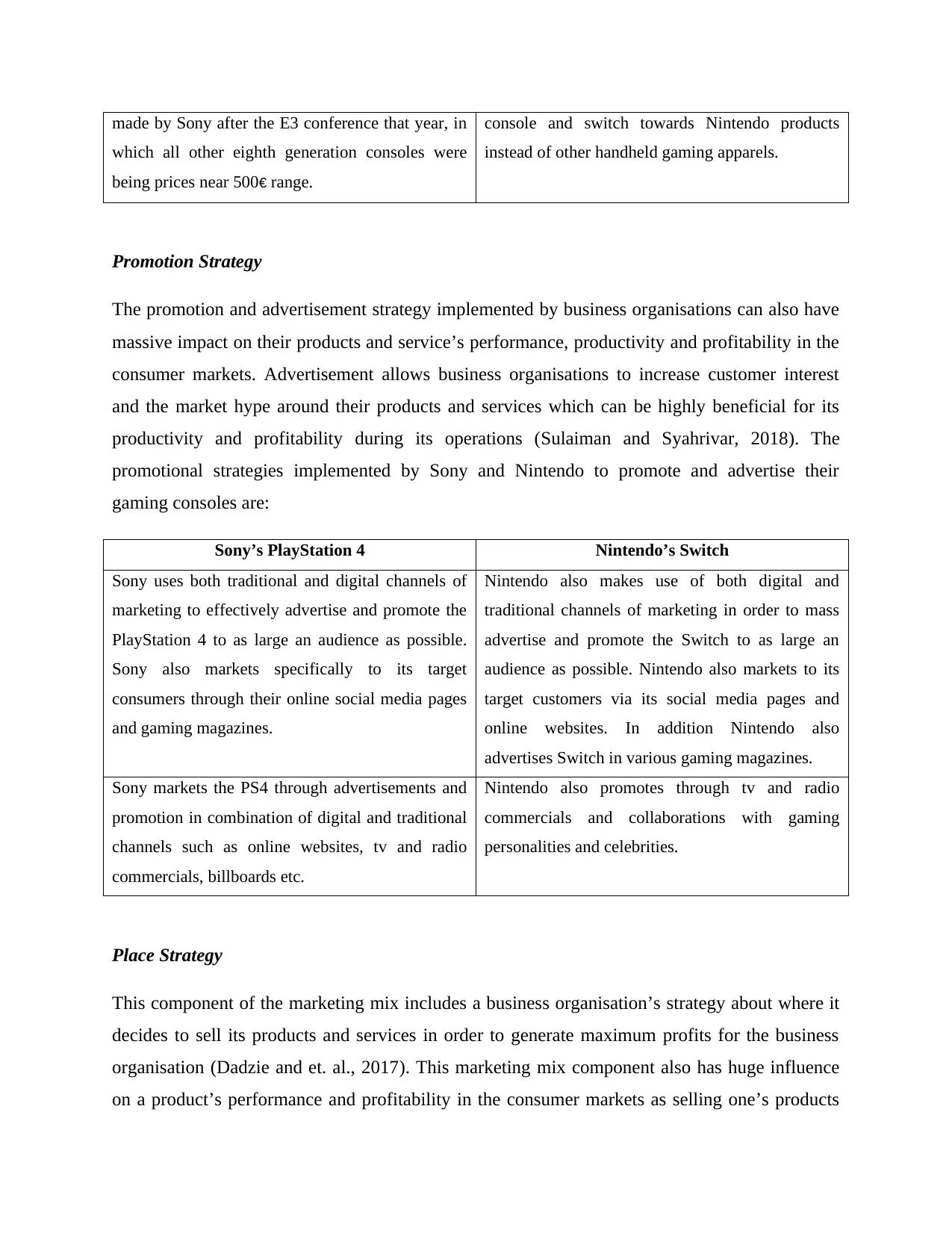
made by Sony after the E3 conference that year, in
which all other eighth generation consoles were
being prices near 500€ range.
console and switch towards Nintendo products
instead of other handheld gaming apparels.
Promotion Strategy
The promotion and advertisement strategy implemented by business organisations can also have
massive impact on their products and service’s performance, productivity and profitability in the
consumer markets. Advertisement allows business organisations to increase customer interest
and the market hype around their products and services which can be highly beneficial for its
productivity and profitability during its operations (Sulaiman and Syahrivar, 2018). The
promotional strategies implemented by Sony and Nintendo to promote and advertise their
gaming consoles are:
Sony’s PlayStation 4 Nintendo’s Switch
Sony uses both traditional and digital channels of
marketing to effectively advertise and promote the
PlayStation 4 to as large an audience as possible.
Sony also markets specifically to its target
consumers through their online social media pages
and gaming magazines.
Nintendo also makes use of both digital and
traditional channels of marketing in order to mass
advertise and promote the Switch to as large an
audience as possible. Nintendo also markets to its
target customers via its social media pages and
online websites. In addition Nintendo also
advertises Switch in various gaming magazines.
Sony markets the PS4 through advertisements and
promotion in combination of digital and traditional
channels such as online websites, tv and radio
commercials, billboards etc.
Nintendo also promotes through tv and radio
commercials and collaborations with gaming
personalities and celebrities.
Place Strategy
This component of the marketing mix includes a business organisation’s strategy about where it
decides to sell its products and services in order to generate maximum profits for the business
organisation (Dadzie and et. al., 2017). This marketing mix component also has huge influence
on a product’s performance and profitability in the consumer markets as selling one’s products
which all other eighth generation consoles were
being prices near 500€ range.
console and switch towards Nintendo products
instead of other handheld gaming apparels.
Promotion Strategy
The promotion and advertisement strategy implemented by business organisations can also have
massive impact on their products and service’s performance, productivity and profitability in the
consumer markets. Advertisement allows business organisations to increase customer interest
and the market hype around their products and services which can be highly beneficial for its
productivity and profitability during its operations (Sulaiman and Syahrivar, 2018). The
promotional strategies implemented by Sony and Nintendo to promote and advertise their
gaming consoles are:
Sony’s PlayStation 4 Nintendo’s Switch
Sony uses both traditional and digital channels of
marketing to effectively advertise and promote the
PlayStation 4 to as large an audience as possible.
Sony also markets specifically to its target
consumers through their online social media pages
and gaming magazines.
Nintendo also makes use of both digital and
traditional channels of marketing in order to mass
advertise and promote the Switch to as large an
audience as possible. Nintendo also markets to its
target customers via its social media pages and
online websites. In addition Nintendo also
advertises Switch in various gaming magazines.
Sony markets the PS4 through advertisements and
promotion in combination of digital and traditional
channels such as online websites, tv and radio
commercials, billboards etc.
Nintendo also promotes through tv and radio
commercials and collaborations with gaming
personalities and celebrities.
Place Strategy
This component of the marketing mix includes a business organisation’s strategy about where it
decides to sell its products and services in order to generate maximum profits for the business
organisation (Dadzie and et. al., 2017). This marketing mix component also has huge influence
on a product’s performance and profitability in the consumer markets as selling one’s products
⊘ This is a preview!⊘
Do you want full access?
Subscribe today to unlock all pages.

Trusted by 1+ million students worldwide
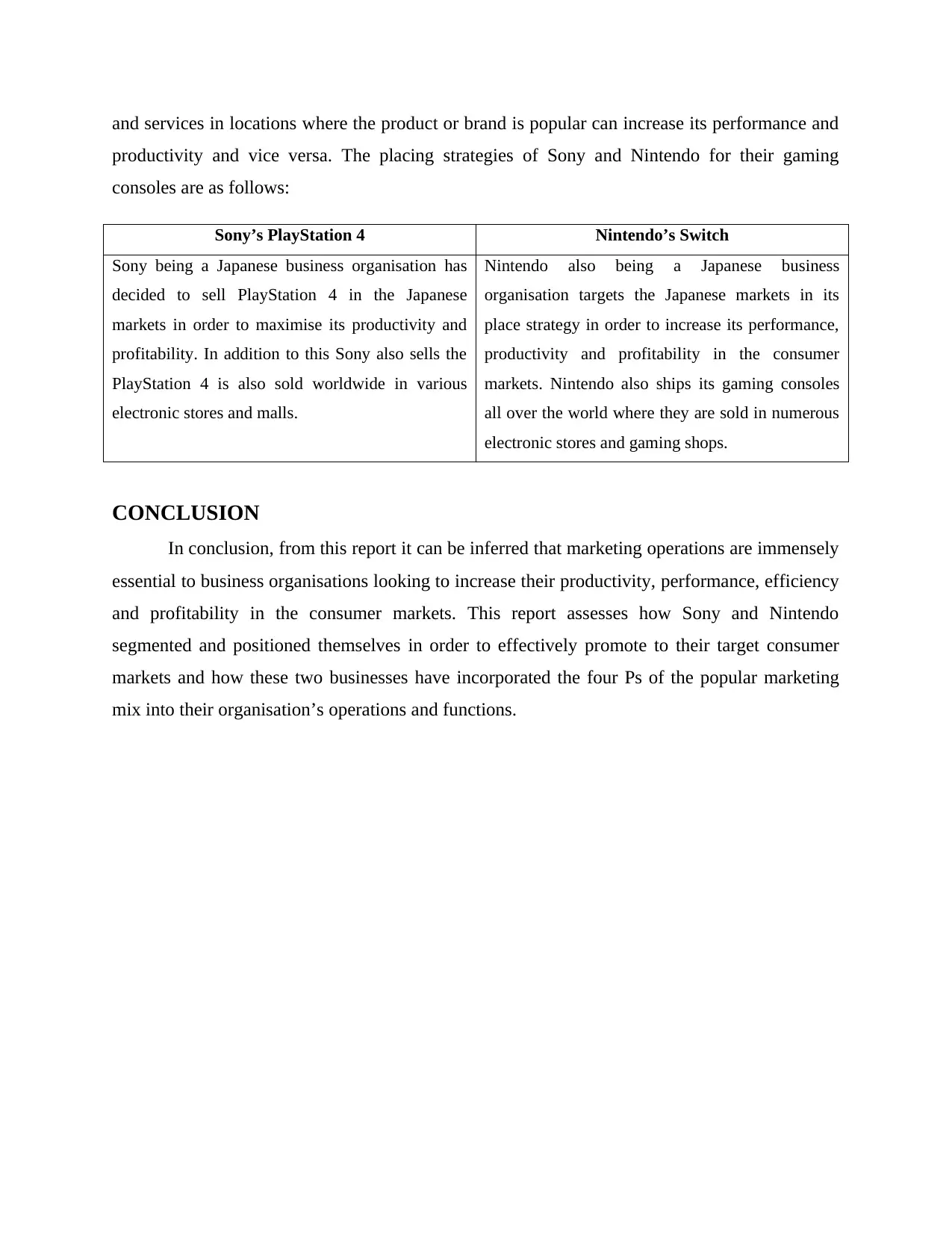
and services in locations where the product or brand is popular can increase its performance and
productivity and vice versa. The placing strategies of Sony and Nintendo for their gaming
consoles are as follows:
Sony’s PlayStation 4 Nintendo’s Switch
Sony being a Japanese business organisation has
decided to sell PlayStation 4 in the Japanese
markets in order to maximise its productivity and
profitability. In addition to this Sony also sells the
PlayStation 4 is also sold worldwide in various
electronic stores and malls.
Nintendo also being a Japanese business
organisation targets the Japanese markets in its
place strategy in order to increase its performance,
productivity and profitability in the consumer
markets. Nintendo also ships its gaming consoles
all over the world where they are sold in numerous
electronic stores and gaming shops.
CONCLUSION
In conclusion, from this report it can be inferred that marketing operations are immensely
essential to business organisations looking to increase their productivity, performance, efficiency
and profitability in the consumer markets. This report assesses how Sony and Nintendo
segmented and positioned themselves in order to effectively promote to their target consumer
markets and how these two businesses have incorporated the four Ps of the popular marketing
mix into their organisation’s operations and functions.
productivity and vice versa. The placing strategies of Sony and Nintendo for their gaming
consoles are as follows:
Sony’s PlayStation 4 Nintendo’s Switch
Sony being a Japanese business organisation has
decided to sell PlayStation 4 in the Japanese
markets in order to maximise its productivity and
profitability. In addition to this Sony also sells the
PlayStation 4 is also sold worldwide in various
electronic stores and malls.
Nintendo also being a Japanese business
organisation targets the Japanese markets in its
place strategy in order to increase its performance,
productivity and profitability in the consumer
markets. Nintendo also ships its gaming consoles
all over the world where they are sold in numerous
electronic stores and gaming shops.
CONCLUSION
In conclusion, from this report it can be inferred that marketing operations are immensely
essential to business organisations looking to increase their productivity, performance, efficiency
and profitability in the consumer markets. This report assesses how Sony and Nintendo
segmented and positioned themselves in order to effectively promote to their target consumer
markets and how these two businesses have incorporated the four Ps of the popular marketing
mix into their organisation’s operations and functions.
Paraphrase This Document
Need a fresh take? Get an instant paraphrase of this document with our AI Paraphraser
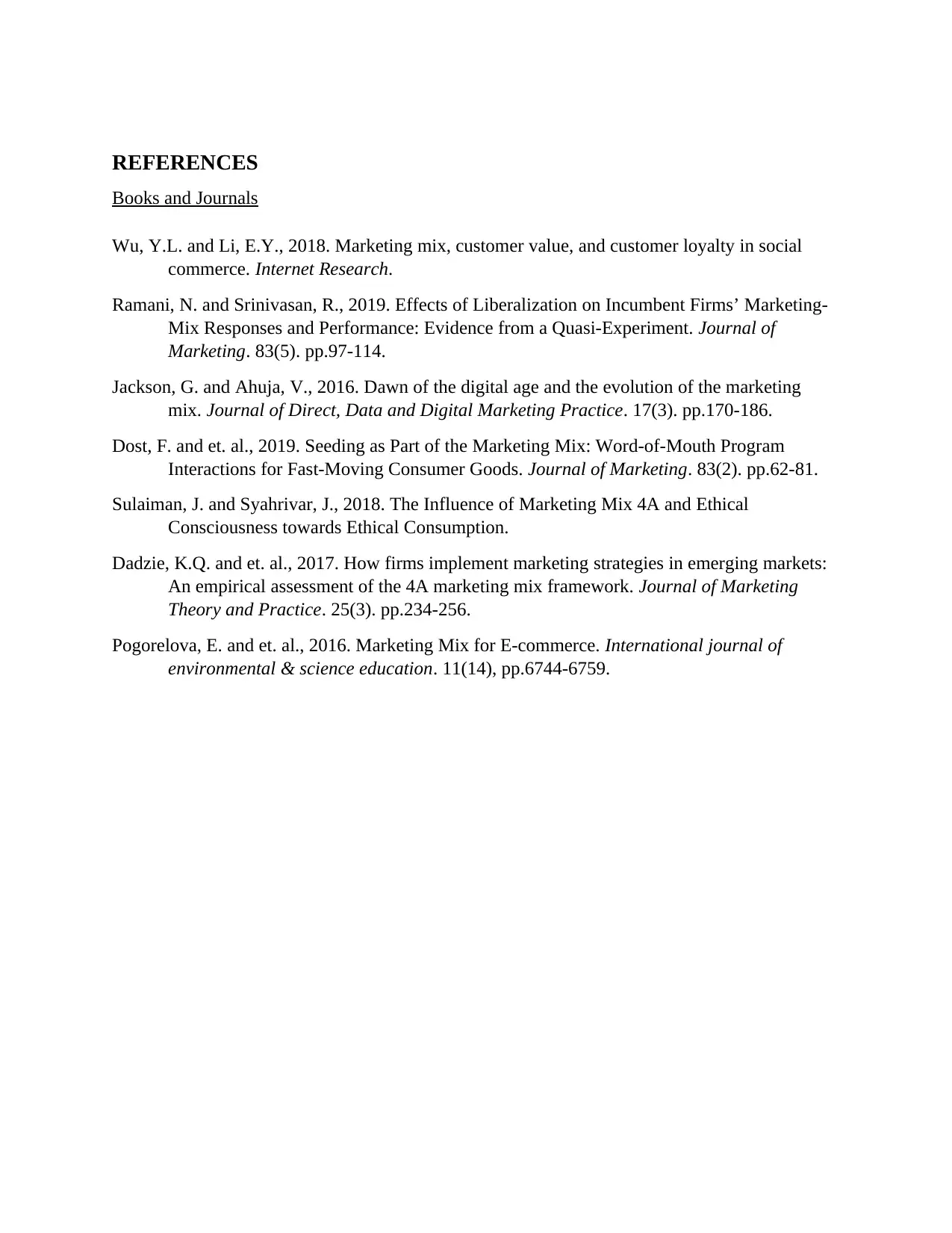
REFERENCES
Books and Journals
Wu, Y.L. and Li, E.Y., 2018. Marketing mix, customer value, and customer loyalty in social
commerce. Internet Research.
Ramani, N. and Srinivasan, R., 2019. Effects of Liberalization on Incumbent Firms’ Marketing-
Mix Responses and Performance: Evidence from a Quasi-Experiment. Journal of
Marketing. 83(5). pp.97-114.
Jackson, G. and Ahuja, V., 2016. Dawn of the digital age and the evolution of the marketing
mix. Journal of Direct, Data and Digital Marketing Practice. 17(3). pp.170-186.
Dost, F. and et. al., 2019. Seeding as Part of the Marketing Mix: Word-of-Mouth Program
Interactions for Fast-Moving Consumer Goods. Journal of Marketing. 83(2). pp.62-81.
Sulaiman, J. and Syahrivar, J., 2018. The Influence of Marketing Mix 4A and Ethical
Consciousness towards Ethical Consumption.
Dadzie, K.Q. and et. al., 2017. How firms implement marketing strategies in emerging markets:
An empirical assessment of the 4A marketing mix framework. Journal of Marketing
Theory and Practice. 25(3). pp.234-256.
Pogorelova, E. and et. al., 2016. Marketing Mix for E-commerce. International journal of
environmental & science education. 11(14), pp.6744-6759.
Books and Journals
Wu, Y.L. and Li, E.Y., 2018. Marketing mix, customer value, and customer loyalty in social
commerce. Internet Research.
Ramani, N. and Srinivasan, R., 2019. Effects of Liberalization on Incumbent Firms’ Marketing-
Mix Responses and Performance: Evidence from a Quasi-Experiment. Journal of
Marketing. 83(5). pp.97-114.
Jackson, G. and Ahuja, V., 2016. Dawn of the digital age and the evolution of the marketing
mix. Journal of Direct, Data and Digital Marketing Practice. 17(3). pp.170-186.
Dost, F. and et. al., 2019. Seeding as Part of the Marketing Mix: Word-of-Mouth Program
Interactions for Fast-Moving Consumer Goods. Journal of Marketing. 83(2). pp.62-81.
Sulaiman, J. and Syahrivar, J., 2018. The Influence of Marketing Mix 4A and Ethical
Consciousness towards Ethical Consumption.
Dadzie, K.Q. and et. al., 2017. How firms implement marketing strategies in emerging markets:
An empirical assessment of the 4A marketing mix framework. Journal of Marketing
Theory and Practice. 25(3). pp.234-256.
Pogorelova, E. and et. al., 2016. Marketing Mix for E-commerce. International journal of
environmental & science education. 11(14), pp.6744-6759.
1 out of 8
Related Documents
Your All-in-One AI-Powered Toolkit for Academic Success.
+13062052269
info@desklib.com
Available 24*7 on WhatsApp / Email
![[object Object]](/_next/static/media/star-bottom.7253800d.svg)
Unlock your academic potential
Copyright © 2020–2025 A2Z Services. All Rights Reserved. Developed and managed by ZUCOL.





